It’s possible that I shall make an ass of myself. But in that case one can always get out of it with a little dialectic. I have, of course, so worded my proposition as to be right either way (K.Marx, Letter to F.Engels on the Indian Mutiny)
Friday, April 02, 2021
Russian human rights activists have released a report that chronicles alleged war crimes and violations of international humanitarian law during the 10-year conflict in Syria
ByThe Associated Press
2 April 2021,
MOSCOW -- Russian human rights activists released a report Friday that chronicles alleged war crimes and violations of international humanitarian law during the 10-year conflict in Syria.
Activists from the Memorial Human Rights Center, the Civic Assistance Committee and other groups interviewed over 150 Syrian refugees in Lebanon, Jordan, Turkey, several European nations and Russia.
The organizations analyzed accounts of arbitrary detentions, enforced disappearances, torture, extrajudicial executions, the use of prohibited weapons against civilians, starvation, sexual violence and other abuses.
The authors said their goal was to fill an information vacuum in Russia regarding the conflict in Syria. They said many Russians remain unaware of the scope of human rights violations and war crimes even though Moscow has waged military action in Syria since 2015.
Russia's military involvement has shored up Syrian President Bashar Assad's rule and allowed his government to reclaim control over much of the country.
“The ongoing violence in Syria and the continued failure to secure justice for those harmed make it more critical than ever that the Russian public is informed about the grave human rights abuses that have occurred in Syria over the last decade, including those committed under Russia’s watch and, since 2015, with its participation,” the report said.
The authors wrote that the Syrian government's military operations conducted jointly or with support from the Russian air force had a “clear pattern of indiscriminate and targeted attacks that did not correspond to the presence of military targets.” The Russian military has staunchly denied striking Syrian civilians.
Given Moscow's role in keeping Assad in power, the activists urged the Russian government to “use its influence on Syrian authorities to end arbitrary arrests, torture and degrading treatment in prisons, extrajudicial killings, and enforced disappearances...(and) support the immediate release of those arbitrarily detained and reveal the fates of the disappeared."
They also called on Russian civil society to build contacts with the Syrian public to conduct joint investigations and prevent rights abuses.
2-Apr-2021
CGTN

Xinjiang, in the far western land of China, hosted one of the world's first and most important trade routes known as the Silk Road, which linked ancient Chinese civilization to the West through the Eurasian continent.
The land of fortune, however, has not always enjoyed tranquility. Thousands of terrorist attacks from 1990 through 2016 killed large numbers of innocent people and hundreds of police officers. Horrific stabbings and bombings wrecked the land, leaving its people in shock, grief and panic. The damage was incalculable while stability in the region quickly deteriorated. Authorities have been trying hard to restore peace to this land.
In CGTN's first three documentaries on fighting terrorism in Xinjiang, we presented never-before-seen footage documenting the frightening tragedies in Xinjiang and the resilience of its people.
The fourth exposé "The war in the shadows: Challenges of fighting terrorism in Xinjiang" – the last of the tetralogy – exposes the extremist thinking and the challenges facing China's efforts to tackle terrorism inside and outside Xinjiang.
It gives answers to these questions: Why has violent terrorism continued to plague Xinjiang? For those who were once known as "Two-faced people" among the legal and political elites in Xinjiang, how much damage have they done to anti-terrorism efforts in the region? How come poisonous education materials alleging ethnic victimization and "Turkic heroes" have been used for 13 years in primary and middle schools? Why must we stop the invisible hand of foreign advocacy abetting violent terrorism infiltrating our country?
The documentary reveals the methods used by extremist and separatist forces including the "Two-faced people" among the region's high-ranking officials, as well as how music and videos advocating violent terrorism and inciting ethnic hatred penetrated the region. Plus, it also tells of the very hardship police officers have been mired in for decades.
Over the past four years, violence has largely been contained, giving way to rapid urbanization and economic growth. Safety and tranquility never come easy. But it's only a preliminary victory in China's fight against terrorism.
The documentary is 55 minutes long and consists of four parts: "The network," "Enemies within," "The textbooks," and "The black hands."
We present you with the first three documentaries — each under an hour — below.
Watch: Fighting terrorism in Xinjiang
Watch: The black hand — ETIM and terrorism in Xinjiang
Watch: Tianshan: Still standing – Memories of fighting terrorism in Xinjiang
Xi Jinping calls for efforts to peak carbon emissions, achieve carbon neutrality
Chinese President Xi Jinping on Friday called on the nation to follow the path of green development and strive to peak carbon emissions and achieve carbon neutrality as scheduled.
President Xi made the remarks while attending an annual voluntary tree-planting activity in Beijing.
China aims to have CO2 emissions peak before 2030 and achieve carbon neutrality before 2060, Xi announced at the general debate of the 75th session of the United Nations General Assembly via video link last September.
Read more:
China gears up for people-centered, green, high-quality development
15 years on: In China, green is new gold
President Xi planted six saplings of different types of trees and talked with some children participating in the activity, encouraging them to strive for all-round development.
This year marks the 40th anniversary of China's voluntary tree-planting campaign, Xi noted. In 1981, the National People's Congress, China's top legislature, launched a nationwide voluntary tree-planting campaign and stipulated that every able-bodied citizen above 11 should plant three to five trees each year.
Thanks to the efforts made by people across the country over the past four decades, China has topped the world in forest resource increase, and the living environment in both urban and rural areas is becoming more and more beautiful, Xi said.
But compared with the goal of building a Beautiful China and the people's new expectations for a good life, forest and grassland resources nationwide are still inadequate in both quantity and quality, he stressed, calling for continuous efforts to plant trees.
Improving the ecological environment is necessary for promoting high-quality development as China enters a new development stage, he said. Greater efforts must be made to promote green development and make China a global pioneer in this regard, he added.
The nation should firmly adhere to the idea that "lucid waters and lush mountains are invaluable assets," he said.
Xi stressed the need to increase the area and quality of forests and the carbon sequestration capacity of the ecological system. The nation should make more efforts to fulfill the goals of peaking carbon emissions and achieving carbon neutrality and make greater contributions to maintaining the ecological security of the world, he said.
(Cover: Saihanba State Forest Park in Chengde, north China's Hebei Province. /Xinhua)
Yu Jing, Li Ruikang
Last week, Stellantis, Nissan and Chinese electric vehicle maker Nio joined an array of other car manufacturers in announcing new production cuts as the global supply of semiconductor chips is running short.
A by-product of the COVID-19 pandemic, looming behind the announcements is a global supply chain crisis that's increasingly taking its tolls on businesses that bank their growth on electronization.
How it all started
As the car market took a hit during the height of the global pandemic, semiconductor orders placed by automakers plummeted. Chip manufacturers thus shifted the focus of their product line to accommodating industries like video game and computer where demand was on the rise due to sweeping stay-at-home orders.

Hi1710 BMC management chip, seen on a Kunpeng 920 chipset designed by Huawei's Hisilicon subsidiary, is on display at Huawei's headquarters in Shenzhen, Guangdong Province, China, May 29, 2019. /Reuters
But as pandemic-induced lockdowns ease worldwide and demand for vehicles has bounced back, car manufacturers are rushing to the now-preoccupied chip foundries for supply, but to no avail.
Given that the entire semiconductor business is built-to-order and that there is an incredibly long lead time due to the complexity of making chips, car makers are either finding themselves put to the back of the line or not expecting the delivery of their semiconductor orders anytime soon.
The shortage has sent shock waves throughout the entire supply chain – car makers run out of chips; chip makers run out of equipment; equipment makers ran out of raw materials, Wang Xiaolong, research director at ICwise, a Shanghai-based market research company in semiconductor and electronics industry, told CGTN.
For vehicles, semiconductor chips are indispensable parts that power up systems ranging from in-car entertainment to driver assistance. The number of semiconductors needed in one vehicle could be as many as hundreds.
But automotive chips, compared with chips for consumer products, are harder to come about through research and development, Wang noted. They must be able to withstand heat, be able to endure under much greater forces and must be highly reliable under all circumstances.

RAM memory chips are seen in this illustration photo, June 21, 2017. /Reuters
The failure to secure chips has sent car manufacturers scrambling to deliver their products. With plants temporarily shut down and production halted, the companies are expected to endure considerable losses this year.
Ford, which recently halted production at two car plants, said it may lose up to $2.5 billion in its 2021 profit, while General Motors said the chip shortage could cost it $2 billion in earnings.
But automakers are not the only ones hit by the chip shortage. Anticipating that the chip supply will keep running short for some time, companies from other sectors have embarked on panic buying, driving up stock prices in the semiconductor industry and increasingly pinching chip capacity.
What was initially a crisis exclusive to the vehicle industry has evolved to one that affects all businesses needing chips in production.
China's path to seeking self-sufficiency in chips
The global chip shortage has pushed carmakers in China to come to see the importance of semiconductor independence. From traditional carmaker Geely to new energy vehicle giant Nio, Chinese automakers are now rushing to design their own chips, but few have achieved the ability of commercial production.
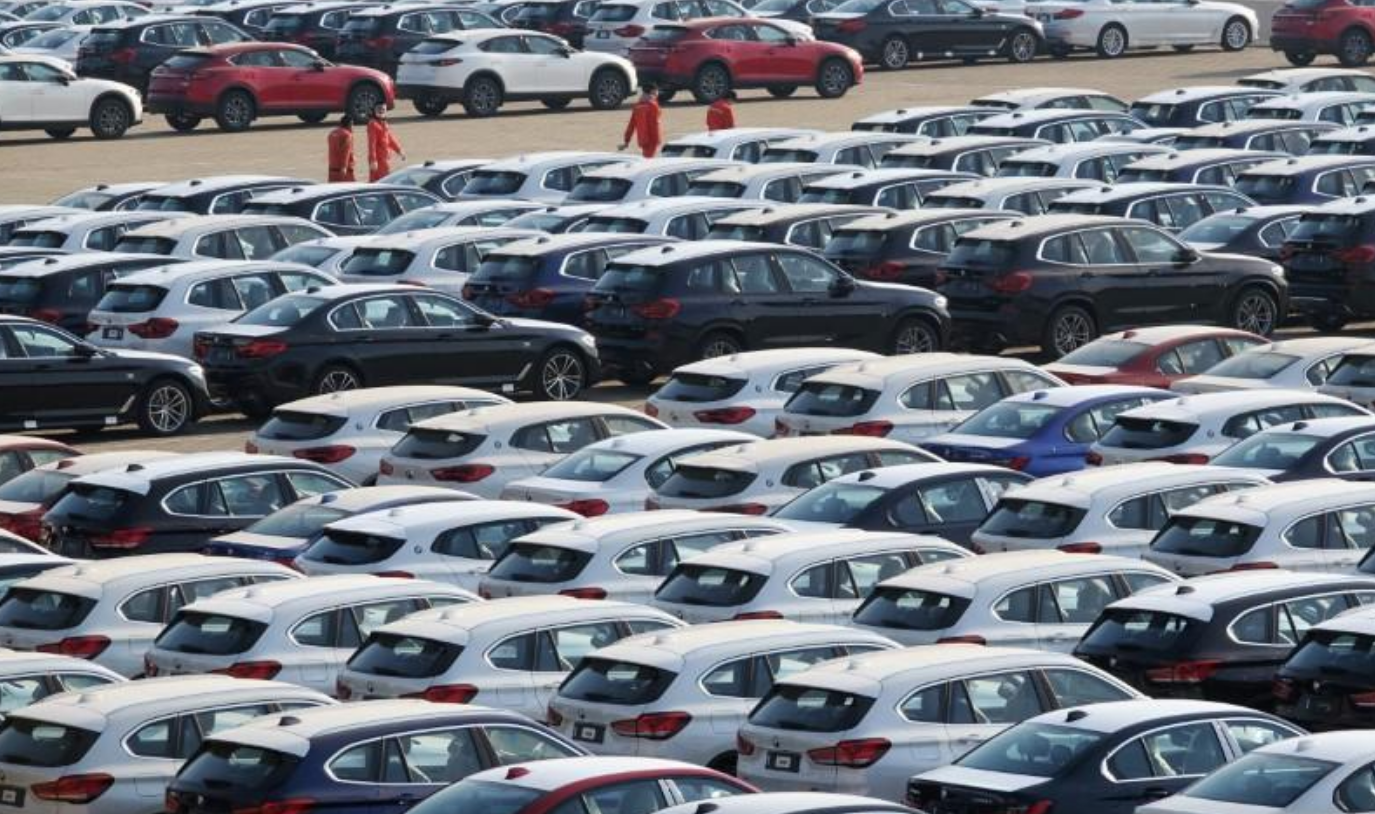
Newly manufactured cars are seen at a port in Dalian, Liaoning Province, China, April 10, 2020. /Reuters
China's resolve to pursue semiconductor independence can stretch back to June 2014, when the State Council announced the establishment of a national investment fund dedicated to the development of semiconductors. Since then, hundreds of policy funds have been established to support the industry, while venture capitalists also turned to investing heavily in semiconductor startups.
According to China Semiconductor Industry Association, China's integrated circuit sales increased by 17 percent in 2020, reaching 884.8 billion yuan ($134.9 billion). But still, the industry is heavily reliant on foreign companies. In 2020, China bought $350 billion worth of foreign integrated circuits, 14.6 percent more than the year before.
A major barrier to achieving semiconductor independence is that China relies on foreign companies for chip-making equipment and design software, Wang noted, so that even if China achieves major progress in chip design, it lacks the equipment to produce them for domestic use.
BYD, one of China's biggest electric vehicle (EV) makers, has long committed to developing its own semiconductors. During the chip shortage, the company said its self-designed chips can not only meet its own demands but also be supplied to others, but analysts have raised doubt about it as the type of chips BYD makes does not necessarily resolve the crying needs.
Nevertheless, the firm has been able to make so-called insulated gate bipolar transistors (IGBT), an integral silicon component in EVs' power management system that's at the core of BYD Semiconductor, for all its vehicles, marking a great leap in the traditionally foreign-dependent sector and a stride towards self-sufficiency.
In 2019, BYD had a share of 18 percent of the IGBT produced in China, while the rest was largely produced by foreign suppliers.
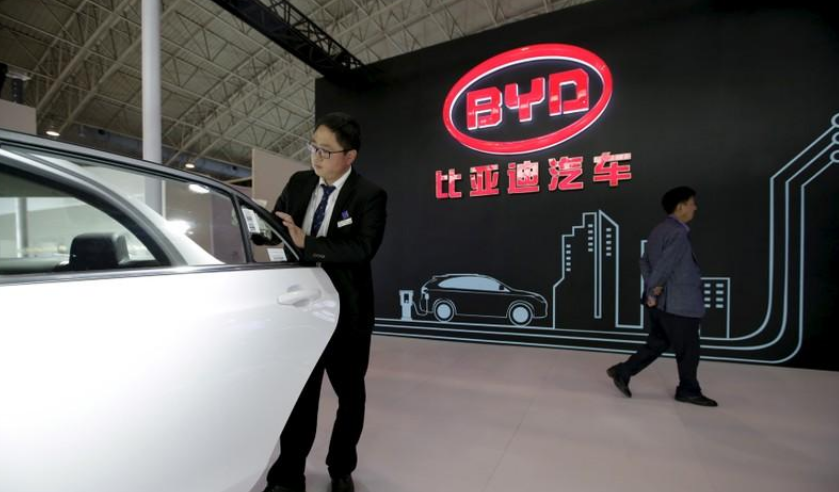
A BYD electric car at the Auto China 2016 in Beijing, China, April 25, 2016. /Reuters
Last year, a large number of chip-related companies sprang up across China, incentivized by the strong state support. According to data from Qichacha, the number of chip-related companies in China increased by 22,800 in 2020, an increase of 195 percent from the previous year.
But still, most of the chip-related companies focus on the downstream operations in the supply chain, instead of the upstream, noted Wang, which means foreign companies that have the stranglehold on raw materials and equipment for chip manufacturing still have a major say over China's chip production.
Late last year, the U.S. Commerce Department imposed restrictions on China's Semiconductor Manufacturing International Corporation from acquiring U.S.-based parts and technologies that are required to produce advanced chips that are 10 nanometers or below. It has also imposed similar restrictions on Chinese smartphone maker Huawei.
"We need to enhance supply chain security from a holistic perspective," Wang noted. "Chips, raw materials, equipment, design tools… every single part of the supply chain is critical to China's pursuit of semiconductor independence."
Michelle Mark
Thu, 1 April 2021,

A radar image taken by the Sentinel-1 satellite shows the Great Bitter Lake on March 31. The Ever Given is the bright ship on the lake's eastern side. Satellite image ©2021 Maxar Technologies
The Ever Given once stuck in the Suez Canal is in an artificial lake with its 18,000 containers.
The giant container ship is awaiting a hull inspection that will decide if it can continue sailing.
In the meantime, a backlog of 422 ships has resumed traffic in the Suez Canal.
Three days after the Ever Given container ship was dislodged from the Suez Canal, it remains anchored in an artificial lake, its future route uncertain.
The ship, operated by the Evergreen Marine Corporation, had been en route to Rotterdam, Netherlands, when it ran aground in the canal on March 23. It remained wedged horizontally for six days, blocking a major global shipping route and becoming an international spectacle.
A spokesperson for Bernhard Schulte Shipmanagement, the company that manages the Ever Given, told Insider the ship is due for a "hull inspection" and will remain in the Great Bitter Lake until it's completed.
Evergreen said in a statement that the upcoming inspection "will determine whether the ship can resume its scheduled service" to Rotterdam.
In the meantime, traffic along the Suez Canal has resumed, though the Suez Canal Authority chairman told reporters on Monday the backlog of 422 ships would take several days to clear.
Another satellite image from Maxar Technologies shows a line of ships steadily making their way down the canal on March 31:

Shipping traffic in the Suez Canal has resumed, after the Ever Given was dislodged on March 29. Satellite image ©2021 Maxar Technologies
The Ever Given initially got stuck in the canal due to high winds from a sandstorm.
SOME WOULD DISAGREEShip captain's 'clumsy manuevers' caused Ever Given
to get stuck in Suez Canal: report
CGTN
The "clumsy maneuvers" from the captain of the mega-ship Ever Given caused it to swerve radically before running aground in Suez Canal, Italian media Nova Agency reported on Friday, citing two officials of the Suez Canal Authority.
The vessel is one of the world's largest container ships - it's roughly the same length as the Empire State Building and can carry up to 20,000 containers. The debacle cost the global economy an estimated $400 million per hour.
Read the original article on Business Insider
Consumer resistance to sustainability interventions
News from the Journal of Marketing
AMERICAN MARKETING ASSOCIATION
Researchers from University of Queensland, University of Melbourne, and Universidad Finis Terrae published a new paper in the Journal of Marketing that studies consumer resistance to a nationwide plastic bag ban implemented in Chile in 2019.
The study, forthcoming in the Journal of Marketing, is titled "How Do I Carry All This Now?': Understanding Consumer Resistance to Sustainability Interventions" and is authored by Claudia Gonzalez-Arcos, Alison M. Joubert, Daiane Scaraboto, and Jörgen Sandberg.
As environmental crisis challenges accelerate, governments are searching for solutions to reduce the negative impacts of economic activity. One popular measure has been to ban disposable plastic bags. Bans on plastic bags may seem like an easy way to reduce plastic pollution, but are often met with strong pushback by consumers, retailers, and other members of society.
The researchers studied consumer resistance to a nationwide plastic bag ban implemented in Chile in February 2019 with the goal of answering the following questions: What causes consumer resistance to sustainability interventions such as bans on plastic bags? And how can consumer resistance be reduced to make such interventions more effective? They conducted interviews, observed consumers, and collected documents, news articles, and social media posts related to the Chilean ban, starting in 2013 when an initial ban in coastal areas was announced until four months after the implementation of the ban in the entire country in 2019.
Gonzalez-Arcos says, "We discovered that consumers refuse to accept or support a sustainability intervention because the individual behaviors being targeted--in this case using disposable plastic bags for shopping--are not separate from, but embedded in, social practices." Social practices are activities, materials, and meanings that are similarly understood and shared by a group of people. Eating, cooking, shopping, driving, and reading are examples of social practices shared by large groups. These practices determine people's way of life and, to a large extent, who they are. From this perspective, a behavior such as using a plastic bag to carry groceries is simply a performance of the socially shared, habituated practice of shopping.
An intervention like banning plastic bags triggers change in the social practice of shopping because plastic bags are one of the materials that constitute this practice. Plastic bags are used in many shopping activities (bagging groceries, carrying them home) and meanings (convenience, speed). To change the social practice of shopping after a plastic bag ban, consumers need to navigate three processes: (1) sensemaking, which means understanding and developing new meanings for the changing shopping practice; (2) accommodating, which means developing new competencies for using and handling the new materials used to shop; and (3) stabilizing, which means performing the changed practice often and efficiently. Consumers do not find these processes easy: engaging in them disrupts routines, lifestyles, and even consumers' perceptions of themselves.
In addition to changed social practices such as shopping, consumers face other challenges that prompt them to resist plastic bag bans. Plastic bags and other sustainability interventions often fail to acknowledge that individual actions are part of broader social practices and aim for individual behavioral change rather than change to the social practice itself. Consequently, consumers face three major challenges: (1) battles about who is responsible for making practices more sustainable; (2) unsettling emotions brought about by the changing practice; and (3) changes to other linked practices that dismantle their ways of life. Once these reasons for consumer resistance are known, they provide greater clarity around why consumers will push back against sustainability interventions.
"Consumer resistance interferes with social practice change, which significantly undermines the effectiveness of the sustainability intervention. Our findings show policy makers and other agents involved in sustainability interventions that changing social practices--not individual behaviors--should be their primary goal," explains Joubert. The study presents a framework for designing and managing practice-based sustainability interventions that considers the role of consumer resistance.
To plan and design a practice-based intervention, the researchers recommend the following steps:
- Identify the practice being targeted (e.g., shopping), and how it is likely to be disrupted (e.g., material will be eliminated--plastic bags).
- Distribute responsibility for change among those involved in the practice (e.g., consumers, retailers, bag manufacturers, government).
- Determine potential emotions that may manifest (positive to leverage and negative to placate).
- Identify links between the targeted practice and other social practices (e.g., the plastic bags used in shopping are also used for garbage and waste management).
Next, to monitor and adjust practice-based interventions if consumer resistance emerges, these three main strategies are recommended:
- Refocus sensemaking if consumers are experiencing tension and lacking focus.
- Encourage accommodation if consumers are avoiding risks and restricting their experimentation during the change process.
- Accelerate stabilization if consumers are grappling with discomfort and do not seem to be able to settle with a new version of the social practice.
###
Full article and author contact information available at: https:/
About the Journal of Marketing
The Journal of Marketing develops and disseminates knowledge about real-world marketing questions useful to scholars, educators, managers, policy makers, consumers, and other societal stakeholders around the world. Published by the American Marketing Association since its founding in 1936, JM has played a significant role in shaping the content and boundaries of the marketing discipline. Christine Moorman (T. Austin Finch, Sr. Professor of Business Administration at the Fuqua School of Business, Duke University) serves as the current Editor in Chief. https:/
About the American Marketing Association (AMA)
As the largest chapter-based marketing association in the world, the AMA is trusted by marketing and sales professionals to help them discover what is coming next in the industry. The AMA has a community of local chapters in more than 70 cities and 350 college campuses throughout North America. The AMA is home to award-winning content, PCM® professional certification, premiere academic journals, and industry-leading training events and conferences. https:/
Social media addiction linked to cyberbullying
Identifying as male and more hours spent online also contributed
UNIVERSITY OF GEORGIA
As social media platforms like Instagram, Snapchat, TikTok and others continue to grow in popularity, adolescents are spending more of their time online navigating a complex virtual world.
New research suggests that these increased hours spent online may be associated with cyberbullying behaviors. According to a study by the University of Georgia, higher social media addiction scores, more hours spent online, and identifying as male significantly predicted cyberbullying perpetration in adolescents.
"There are some people who engage in cyberbullying online because of the anonymity and the fact that there's no retaliation," said Amanda Giordano, principal investigator of the study and associate professor in the UGA Mary Frances Early College of Education. "You have these adolescents who are still in the midst of cognitive development, but we're giving them technology that has a worldwide audience and then expecting them to make good choices."
Cyberbullying can take on many forms, including personal attacks, harassment or discriminatory behavior, spreading defamatory information, misrepresenting oneself online, spreading private information, social exclusion and cyberstalking.
The study surveyed adolescents ranging in age from 13-19 years old. Of the 428 people surveyed, 214 (50%) identified as female, 210 (49.1%) as male, and four (0.9%) as other.
Exploring social media addiction
When adolescents are online, they adapt to a different set of social norms than when they're interacting with their peers in person. Oftentimes, they are more aggressive or critical on social media because of the anonymity they have online and their ability to avoid retaliation. Additionally, cyberbullies may feel less remorse or empathy when engaging in these behaviors because they can't see the direct impact of their actions.
"The perpetrator doesn't get a chance to see how damaging their bullying is and to learn from their mistakes and do something different," said Giordano. "It's a scary situation because they don't have the natural consequences they do with offline bullying."
Teenagers who are addicted to social media are more likely to engage in cyberbullying, as well as those who spend more time online. Participants in the study reported spending on average over seven hours online per day, and the reported average maximum hours spent online in one day was over 12 hours.
"Social media addiction is when people crave it when they're not on it, and continue their social media use despite negative consequences," said Giordano. "Some negative consequences could be they're tired during the day because they're scrolling all night long, they're having conflicts with their parents, they're getting poor grades in school or they're engaging in actions online that they later regret, but they still continue to use social media."
Social networking sites are designed to give people a dopamine hit, she added, and some people compulsively look for that hit. "It's feeding into that addictive behavior, and they may be using cyberbullying as a way to get likes, shares, comments and retweets," she said. "That's the common thread you see in behavioral addictions--people start relying on a rewarding behavior as a way to make them feel better when they're experiencing negative emotions. And so, I think the social media addiction piece is really interesting to show that there's another factor at play here in addition to the number of hours spent online."
The study also found that adolescent males are more likely to engage in cyberbullying than females, aligning with past studies that show aggressive behaviors tend to be more male driven. More research on the socialization process of men can help determine what's leading them to engage in more cyberbullying behaviors.
Next steps for counselors and clinicians
Giordano believes that counselors need to start assessing adolescents for social media addiction if they are engaging in cyberbullying and to provide treatment plans to help redefine their relationship with technology. These interventions may include helping adolescents examine how they define their self-worth and restricting the amount of time they spend on social media platforms.
"There's quite a few strong and reliable assessments for social media addiction for adolescents that have good psychometric properties," said Giordano. "I think when clinicians see cyberbullying happen, they really need to explore the individual's relationship with social media and to address social media addiction, not just the cyberbullying."
Often, school counselors are not aware of cyberbullying until after an incident occurs. To address this issue, Giordano recommends that schools start educating students earlier about cyberbullying and social media addiction as a preventive method instead of waiting to repair the damage. Whether it's through an awareness campaign or support group, schools can help students talk about cyberbullying to give them a chance to understand the consequences of their actions and prepare them for potential risks.
"We need schools and school counselors to do this preventative work early and educate students about the risk of addiction with some of these rewarding behaviors like gaming and social media," said Giordano. "We need to teach them the warning signs of behavioral addiction, what to do if they start to feel like they're losing control over their behaviors and help them find other ways to manage their emotions, rather than turning to these behaviors. There are a lot of programs already moving in this direction, and I think that's amazing and there needs to be more of it."
Counselors can help decrease the risk of some of these addictive behaviors at a young age by teaching and equipping children with emotional regulation skills and other ways to cope with their feelings.
"If you think about it, adolescents are not only figuring out who they are offline, but they're also trying to figure out who they want to be online," said Giordano. "We're giving them even more to do during this developmental period, including deciding how they want to present themselves online. I think it's a complex world that we're asking adolescents to navigate."
###

A shape less recognizable each week, a purpose more obscure.
For the first time on record, a majority of U.S. adults do not belong to a church, synagogue, or mosque.
Since 1939, Gallup has been surveying Americans on their religious affiliations. From that year until the turn of the millennium, church membership in the U.S. never dipped below 68 percent. But over the past two decades, that figure has steadily declined — and now, the emerging churchless majority has arrived.
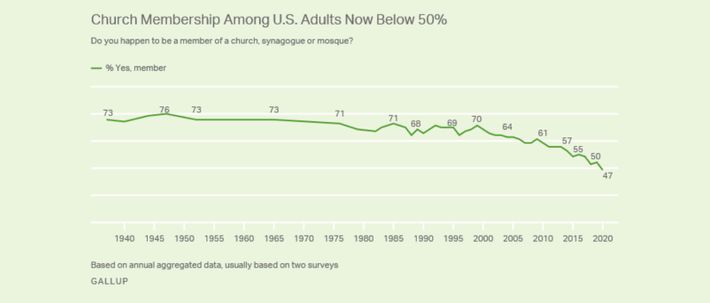
Graphic: Gallup
This is not a story about the rise of “remote worship.” Declining church membership has been driven primarily by rising godlessness. On the eve of the 21st century, 8 percent of Americans identified with no religion in Gallup’s polling. Today, that figure is 21 percent.
Pew Research believes the ranks of the “nones” are even larger. In its polling, 26 percent of the U.S. public prostrates itself before no deity.
In assigning culpability for this trend, one could assemble a long list of plausible co-conspirators. The ascendance of the Evangelical right likely damaged Christianity’s brand with social liberals by associating the faith with theocratic politics, while pedophilic priests and their enablers surely drove no small number of American Catholics from the pews. In Gallup’s polling, the decline in church membership has been especially steep among self-identified Catholics, falling 18 points since 2000, compared to 9 points among Protestants.
But in all likelihood, these contingent developments only expedited America’s atheistic drift. Secularization is a secular trend. In both Gallup and Pew’s data, the main engine of ascendant faithlessness is generational churn. Two-thirds of Americans born before 1946 belong to a religious institution, according to Gallup. That drops to 58 percent among baby boomers, 50 percent among Generation X, and 36 percent among millennials (the pollster’s limited data from zoomers indicates that they are roughly as irreligious as their cooler, wiser immediate predecessors).
Pew shows a similar pattern on the question of religious identification: Each new generation is less religious than the last, while the drop-off between Gen X and millennials is especially sharp:
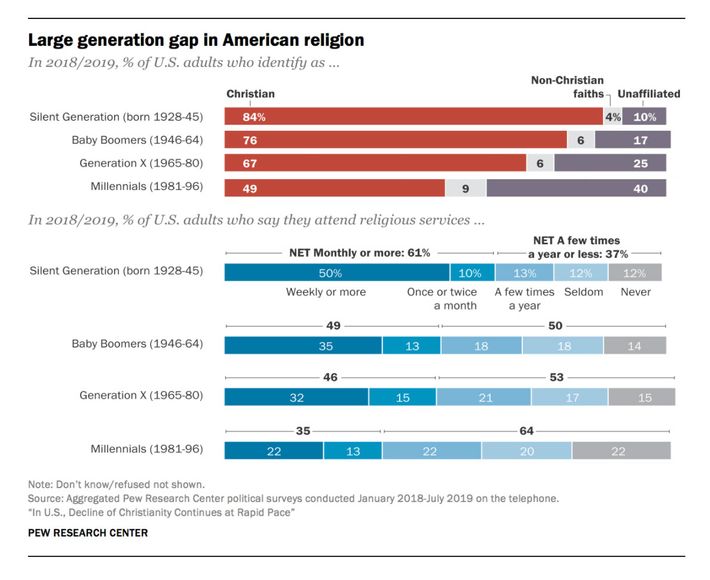
Graphic: Pew Research Center CLICK TO ENLARGE
To be sure, one might attribute American millennials’ disaffection with religion to the fact that the Christian right (and/or Catholic church sex abuse scandal) loomed especially large during their formative years. But declining religiosity is not limited to the United States. Rates of religious-service attendance are falling in nearly every Western country. And the United Kingdom — whose Conservative Party endorsed same-sex marriage before Barack Obama did — has witnessed a remarkably similar trend to the U.S. in religious identification, with the percentage of Britons who subscribe to no religion rising 12 points since 2000.
Given that religious identification has been declining continuously with each new generation, across a diverse array of national contexts, the fundamental cause of the phenomenon is likely structural (as opposed to contingent). I can’t tell you with much authority what this macrohistorical cause is. But I’m inclined to think that industrial development inherently undermines tradition and cultivates individualism, qualities that render it an adversary of faith-based, communitarian institutions. It also seems to me that late capitalism has robbed the church of its monopoly on a wide range of social functions: The welfare state provides social insurance; the universities, metaphysics; Marvel movies, community-binding myths (what are MCU Reddit forums but Bible studies persevering?).
Regardless, my point in emphasizing the deep-seated, structural nature of declining religiosity is simple: It suggests that this trend will not be drastically reversed, absent some kind of social cataclysm.
And that poses a major challenge to the Republican Party.
America’s loss of faith may have won Biden the presidency.
Everyone knows that religion is a major fault line in American politics. But its exceptional salience has been occluded a bit in recent years, as divisions rooted in race and educational attainment have attracted heightened attention. Much digital ink has spilled on the growing split between white voters with college degrees and those without them. And rightly so. Yet it remains the case that whether a white American identifies as an Evangelical Christian is a much more reliable predictor of her partisan preference than whether she went to college.
This reality helps explain some curious aspects of contemporary politics. For example, many pundits have puzzled over the divergent political trajectories of Wisconsin and Ohio. Although both states have shifted right since the Obama era, the former has remained competitive while the latter has gone solid red. If one focuses on race and education, this split is hard to explain. Both states are heavily working-class, with nearly identical percentages of Ohioans and Wisconsinites holding college degrees, while African Americans comprise roughly twice as large a share of Ohio’s population as they do of Wisconsin’s. Thus, if you only looked at these two variables, you’d assume that the Buckeye State was the bluer battleground. But religiosity presents a countervailing distinction. In Pew’s polling, 58 percent of Ohioans say they are “highly religious,” which makes their state the 17th-most religious in the country. By contrast, only 45 percent of Wisconsinites identify as highly religious; only five states demonstrate lower levels of religiosity, and all of them are blue.
As the GOP’s electoral fortunes in Ohio (and beyond) indicate, there are worse fates than being the party of white Christians in a time of deepening education polarization. The “moral majority” may in fact be an ever-shrinking minority. But it is also disproportionately concentrated in rural areas that are overrepresented at every level of government. This reality, combined with the GOP’s Trump-era gains among secular noncollege whites — who are also overrepresented in both rural America and the Midwest’s Electoral College battlegrounds — has enabled Republicans to assemble an extraordinarily efficient coalition. While Democrats waste votes by running up the score in urban House districts and a handful of coastal states, Republicans are spread comparatively evenly across the geography of most regions, and are superabundant in the wildly overrepresented Great Plains states.
Nevertheless, geographic efficiency isn’t worth much without numerical sufficiency. In 2020, the Electoral College’s tipping-point state was nearly 4 points more Republican than the nation as whole. But the nation as a whole gave Donald Trump the lowest share of the popular vote that any incumbent president had received since Herbert Hoover. So Trump lost.
The emerging churchless majority may well have been integral to Trump’s plight. In 2016, the mogul was all things to all white cultural conservatives: His reputation as an infamous philanderer reassured a critical mass of a secular, working-class Obama voters in the Midwest that his Bible-thumping was insincere, while his avid support from megachurch pastors (and Mike Pence) kept the Evangelical right in his corner. After four years in power, however, the voting public came to regard Trump as more of a conventional conservative. And his support among the religiously unaffiliated appeared to decline: In Pew’s data, Clinton won the godless by 41 points, while Biden won them by 49.
If those figures are broadly accurate, then the shift they reflect surely helped Biden secure his narrow margins in key Midwestern states. The pious aren’t as overrepresented in the Rust Belt battlegrounds as the non-college-educated are: On Pew’s list of America’s most religious states, Michigan, Pennsylvania, Minnesota, and Wisconsin are all in the bottom half.
The GOP is caught between the median voter and the moral minority.
Of course, the difficulty for Republicans is less that their coalition is more religious than America writ large than that it is wildly more theocratic and reactionary. For decades, Gallup has taken the public’s temperature on the moral acceptability of various social practices. In 2017, it found that on 10 of its 19 “moral” issues, American opinion had become historically left-wing, while the electorate’s views had grown significantly more conservative on exactly zero.
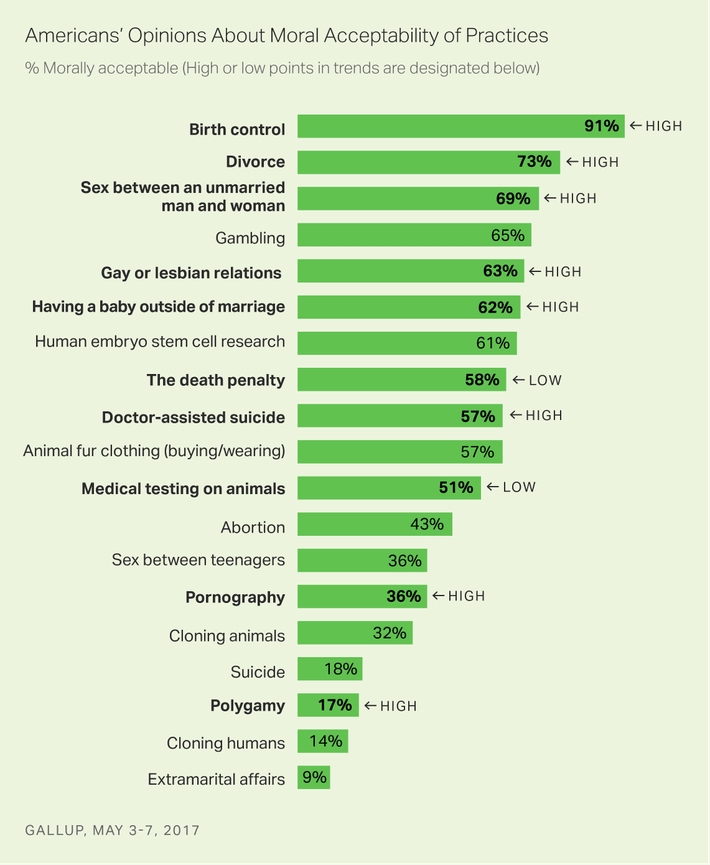
This trend is all but certain to continue apace over the coming decade, since it’s driven by the same generational churn that’s emptying America’s pews. As millennials and zoomers replace silents and boomers, it will be increasingly difficult for the GOP to win national elections without distancing itself from moral traditionalism. Marijuana legalization, LGBT rights, and Roe v. Wade are all popular and becoming more so.
The challenge that declining religiosity poses to the Republican Party is therefore twofold. First, the trend directly shrinks the party’s core constituency of white Evangelicals, while expanding the core Democratic constituency of the irreligious. Until recently, the GOP may have actually benefited from the decline of Protestantism in the U.S., as erosion in church membership was concentrated in mainline congregations that were disproportionately affiliated with the Democrats. But over the past decade, the ascent of the millennials and sunset of the boomers have reduced the weight of conservative Christians in the electorate. Between 2009 and 2019, the share of the U.S. population that identified as white Evangelical (or born-again) Protestants dropped from 19 to 16 percent in Pew’s polling. At the same time, the growth in the unchurched population has directly increased the Democrats’ vote share: Since 2004, the Democratic nominee has never won less than 67 percent of the religiously unaffiliated.
The second problem is that the GOP’s most loyal and best-organized mass constituency — the Evangelical right — is increasingly out of touch with mainstream opinion. This tension has been further heightened by the exodus of college-educated professionals from the GOP coalition, which has allowed the “moral minority” to retain (if not increase) its clout within the party, even as its influence over the broader culture has steadily eroded.
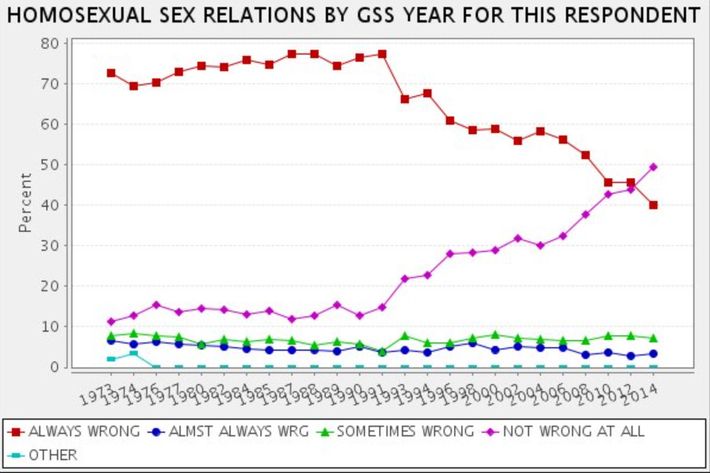
Graphic: @xenocryptsite/Twitter
Republicans have responded to this challenge in part by strategically retreating on some culture-war issues and escalating hostilities on more ecumenical ones. In 2015, the Supreme Court neutralized the wedge issue of same-sex marriage, and the GOP proceeded to drop the subject from its national messaging. Republican presidential hopefuls still cling to radical positions on reproductive rights, with Marco Rubio supporting the prohibition of abortion even in cases of rape and incest. But most have followed Trump’s lead in centering issues that unite religious and secular reactionaries, from immigration to “cancel culture” to belligerent anti-China policy.
Given the GOP’s large structural advantage in the Electoral College, it could conceivably build a winning coalition atop terror of migrants and reverence for racist Dr. Seuss books. After all, not all of our polity’s long-term trends cut against Republicans. The assimilation of Hispanic Americans into white identity is one tailwind for the party. And even the decline of religion isn’t without its upside for the right. Although the development hurts Republicans with white voters, the decline of the Black church appears to be helping them with African Americans — both because such institutions are critical for promoting Black turnout, and because unchurched Black voters are a bit less likely to adhere to their community’s traditional partisan preference.
Nevertheless, the Republicans’ dependence on an increasingly minor religious movement will be a major liability in 2024. The days of Anthony Kennedy nullifying debates that divide the Christian right from the broader populace are over. Today’s conservative Supreme Court is far more likely to increase the salience of such wedge issues than it is to sideline them. And neither Marco Rubio nor Josh Hawley nor Tom Cotton boasts Donald Trump’s innate connection with those who disdain both political correctness and piety.
The Christian right’s answer to declining religiosity is the suspension of democracy.
Whatever its impact on the GOP, the implications of creeping secularism are more dire for social conservatives. The Republican Party can ultimately retain political power by bringing its policy commitments into slightly closer alignment with public opinion. That is not an option for the Christian right’s true believers. As a result, the movement is becoming forthrightly anti-democratic. On the one hand, the moral minority hopes to impose its will on the nation by judicial fiat. On the other, it aims to disenfranchise the heathen majority.
Liberal analyses of the GOP’s war on voting rights tend to characterize it as a reaction against the nation’s burgeoning racial diversity. And this is surely one driver of the phenomenon. But it’s worth noting that the eclipse of conservative Christian America is real, while that of majority-white America is a paranoid delusion. According to Census Bureau projections, white Americans will still comprise over 68 percent of the U.S. population in 2060, so long as one includes Hispanic Americans who identify as white in that category. The complexion of America’s white majority may shift, as it has many times before. But it’s not actually disappearing. White conservative Christians, by contrast, are already a minority of the U.S. electorate.
It’s not surprising then that many of the right’s most unabashed advocates for authoritarianism hail from its religious wing. And while no respectable conservatives will publicly argue that nonwhite Americans are unfit for self-government, many are quite comfortable saying as much about the nation’s socially liberal majority. Glenn Elmers, a senior fellow at the Claremont Institute and research scholar at Hillsdale College, made the case vividly this week:
[M]ost people living in the United States today — certainly more than half — are not Americans in any meaningful sense of the term … They do not believe in, live by, or even like the principles, traditions, and ideals that until recently defined America as a nation and as a people. It is not obvious what we should call these citizen-aliens, these non-American Americans; but they are something else …
Authentic Americans still want to have decent lives. They want to work, worship, raise a family, and participate in public affairs without being treated as insolent upstarts in their own country. Therefore, we need a conception of a stable political regime that allows for the good life. The U.S. Constitution no longer works.
The Republican Party can still compete for political supremacy within America’s existing institutions. But its moral traditionalists cannot regain cultural hegemony absent some kind of a counterrevolution. If such a project is practically implausible, it is increasingly ideologically permissible on the right side of the aisle. Thus, the coming decade of U.S. politics may be defined, in part, by the struggle to prevent conservative Christianity from taking democracy down with it.
"There's extensive primary source documentation to show the American colonies were bases of operation for pirates,"
1 Apr, 2021
/cloudfront-ap-southeast-2.images.arcpublishing.com/nzme/VY2DMYHYH36PVCJYWOJJIQPADE.png)
An 18th-century depiction of Captain Henry Every, with the Fancy shown in the background. Image / Wikipedia
AP
By: William J. Cole
A handful of coins unearthed from a pick-your-own-fruit orchard in rural Rhode Island and other random corners of the American state of New England may help solve one of the planet's oldest cold cases.
The villain in this tale: a murderous English pirate who became the world's most-wanted criminal after plundering a ship carrying Muslim pilgrims home to India from Mecca, then eluded capture by posing as a slave trader.
"It's a new history of a nearly perfect crime," said Jim Bailey, an amateur historian and metal detectorist who found the first intact 17th-century Arabian coin in a meadow in Middletown.
That ancient pocket change — among the oldest found in North America — could explain how pirate Captain Henry Every vanished into the wind.
/cloudfront-ap-southeast-2.images.arcpublishing.com/nzme/6XM2UFZRUKIF27I3WBTCSVQPQY.jpg)
On September 7, 1695, the pirate ship Fancy, commanded by Every, ambushed and captured the Ganj-i-Sawai, a royal vessel owned by Indian emperor Aurangzeb, then one of the world's most powerful men. Aboard were not only the worshipers returning from their pilgrimage, but tens of millions of dollars' worth of gold and silver.
What followed was one of the most lucrative and heinous robberies of all time.
Historical accounts say his band tortured and killed the men aboard the Indian ship and raped the women before escaping to the Bahamas, a haven for pirates. But word quickly spread of their crimes, and English King William III — under enormous pressure from a scandalised India and the East India Company trading giant — put a large bounty on their heads.
"If you Google 'first worldwide manhunt,' it comes up as Every," Bailey said. "Everybody was looking for these guys."
/cloudfront-ap-southeast-2.images.arcpublishing.com/nzme/B4H72P4PDSOEDND37RC3ZVQKCA.jpg)
Until now, historians only knew that Every eventually sailed to Ireland in 1696, where the trail went cold. But Bailey says the coins he and others have found are evidence the notorious pirate first made his way to the American colonies, where he and his crew used the plunder for day-to-day expenses while on the run.
Waving a metal detector over the soil, he got a signal, dug down and hit literal paydirt: a darkened, dime-sized silver coin he initially assumed was either Spanish or money minted by the Massachusetts Bay Colony.
Related articles
Peering closer, the Arabic text on the coin got his pulse racing. "I thought, 'Oh my God'."
Research confirmed the exotic coin was minted in 1693 in Yemen. That immediately raised questions, Bailey said, since there's no evidence that American colonists struggling to eke out a living in the New World travelled to anywhere in the Middle East to trade until decades later.
Since then, other detectorists have unearthed 15 additional Arabian coins from the same era — 10 in Massachusetts, three in Rhode Island and two in Connecticut. Another was found in North Carolina, where records show some of Every's men first came ashore.
/cloudfront-ap-southeast-2.images.arcpublishing.com/nzme/VBVVKP3LNGP3NQI6XBBMKDMW6Q.jpg)
"It seems like some of his crew were able to settle in New England and integrate," said Sarah Sportman, state archaeologist for Connecticut, where one of the coins was found in 2018 at the ongoing excavation of a 17th-century farm site.
"It was almost like a money-laundering scheme," she said.
Although it sounds unthinkable now, Every was able to hide in plain sight by posing as a slave trader — an emerging profession in 1690s New England. On his way to the Bahamas, he even stopped at the French island of Reunion to get some Black captives so he'd look the part, Bailey said.
Obscure records show a ship called the Sea Flower, used by the pirates after they ditched the Fancy, sailed along the Eastern seaboard. It arrived with nearly four dozen slaves in 1696 in Newport, Rhode Island, which became a major hub of the North American slave trade in the 18th century.
"There's extensive primary source documentation to show the American colonies were bases of operation for pirates," said Bailey, 53, who holds a degree in anthropology from the University of Rhode Island and worked as an archaeological assistant on explorations of the Wydah Gally pirate ship wreck off Cape Cod in the late 1980s.
Bailey, whose day job is analysing security at the state's prison complex, has published his findings in a research journal of the American Numismatic Society, an organisation devoted to the study of coins and medals.
/cloudfront-ap-southeast-2.images.arcpublishing.com/nzme/VY2DMYHYH36PVCJYWOJJIQPADE.png)
Archaeologists and historians familiar with Bailey's work say they're intrigued, and believe it's shedding new light on one of the world's most enduring criminal mysteries.
"Jim's research is impeccable," said Kevin McBride, a professor of archaeology at the University of Connecticut. "It's cool stuff. It's really a pretty interesting story."
Mark Hanna, an associate professor of history at the University of California-San Diego and an expert in piracy in early America, said that when he first saw photos of Bailey's coin, "I lost my mind.
"Finding those coins, for me, was a huge thing," said Hanna, author of the 2015 book, Pirate Nests and the Rise of the British Empire.
"The story of Captain Every is one of global significance. This material object — this little thing — can help me explain that."
Every's exploits inspired a 2020 book by Steven Johnson, Enemy of All Mankind; PlayStation's popular Uncharted series of video games; and a Sony Pictures movie version of Uncharted starring Tom Holland, Mark Wahlberg and Antonio Banderas that's slated for release early in 2022.
Bailey, who keeps his most valuable finds not at his home but in a safe deposit box, says he'll keep digging.
"For me, it's always been about the thrill of the hunt, not about the money. The only thing better than finding these objects is the long-lost stories behind them."
Ivanka Trump's women's initiative branded a failure by US government auditors
/cloudfront-ap-southeast-2.images.arcpublishing.com/nzme/K4PBTICESE4F5TXAQ4GBQ5DDJA.jpg)
An initiative championed by Ivanka Trump has been branded a failure.
The women's empowerment initiative championed by Ivanka Trump throughout her father's presidency has been branded a failure, in a damning new report by America's Government Accountability Office (GAO).
Donald Trump's 39-year-old eldest daughter, former senior adviser and "heir apparent" – who is supposedly working to "redeem" and "rebrand" herself as she sets her eyes on the White House – spent most of her time in Washington claiming to be working on behalf of women both at home and abroad.
The Women's Entrepreneurship and Economic Empowerment Act, which Ms Trump helped usher through Congress in 2018, was a legislative overhaul of programmes assisting small businesses run by women around the world.
Now, a review by officials at the GAO has found that programmes funded through the initiative were deeply flawed and hampered by poor oversight, never working out "an explicit definition" of who was eligible to receive US$265 million per year in aid.
While the mother-of-three didn't directly oversee the programme, she promoted her role in expanding federal aid programmes to target female entrepreneurs. In an early 2019 interview, she vowed to "rigorously track the execution and efficacy of the money that we were spending".
/cloudfront-ap-southeast-2.images.arcpublishing.com/nzme/6QC36CCLSRFHMI4HTZZ5IGJCGI.jpg)
"(Ivanka) Trump's stump speech on the global conference circuit was anchored in stories about the legal and regulatory barriers many women face around the world in establishing their property rights and starting businesses, and she had a solution: W-GDP (Women's Global Development and Prosperity Initiative)," Ryan Heath wrote in an article for Politico.
"Launched weeks after President Trump signed the WEEE Act in early 2019, supporters of W-GDP saw it as a groundbreaking whole-of-government approach to female empowerment. Critics of W-GDP derided the work as too limited to make a real difference."
Supposedly, the programme's hope "was that poor women entrepreneurs would receive the financial kick start they needed to build a business". Half of the annual funds were required to go to women, the other half to the "very poor", with some overlap between the two groups expected.
But despite its intentions, and Ms Trump's claims of "rigorously" tracking the "execution and the efficacy of the money that we are spending", there were "extensive failures in both the targeting of the money, and the measurement of its impact", the GAO audit found.
The initiative "was unable to say what proportion of funds went to the very poor, and women-owned and managed businesses".
"Shockingly, the agency couldn't even define what actually constitutes a business owned and run by women, the GAO concluded," Heath wrote.
A senior Trump administration official who worked on W-GDP, speaking to Politico, attributed the issues to the initiative inheriting a "tangled mess of women's policy programmes in 2017".
"Everything was scattered with no real clear goal or purpose. That is not a good use of taxpayer dollars and doesn't help people anywhere," the former official said.
The report's release comes as rumours continue to swirl about Ms Trump's political future.
According to some, she plans to run for President herself in the not-too-distant future; others say that she could serve as Vice-President under her father if he were to win in 2024; that she aims to challenge Florida Republican Senator Marco Rubio in 2022 – although that path now seems to have been ruled out – or run for Florida governor.
/cloudfront-ap-southeast-2.images.arcpublishing.com/nzme/GAD3MHF4FTDOMTY4Z4GNSARCB4.jpg)
US political commentator and author Spencer Critchley, a former communications consultant for Barack Obama's presidential campaigns, previously told news.com.au's Alexis Carey that Ms Trump's recent behaviour indicated she was seriously considering a political move.
He said some clues regarding her political ambitions include her adoption of "ostentatiously virtuous positions on non-controversial topics like motherhood or being kind to each other", ensuring she remains in the public eye, being "very carefully groomed and presented" in public and attending official state events during the Trump administration, such as the G20 summit in Japan in 2019.
But, attention was now turning to a string of "questionable" actions undertaken by Ms Trump before and during her time as adviser to the president, possibly threatening her future career path, he said.
"It seems clear with the hints she's dropped over the years that she thinks (running for office) is the logical next step," he told news.com.au.
"But Ivanka is obviously completely unqualified in terms of her experience but also in terms of her character – in many ways she's similar to her father and she has certainly had some very shady dealings.
"Ivanka, from the beginning and even before the Trump administration, had been involved in very questionable stuff."